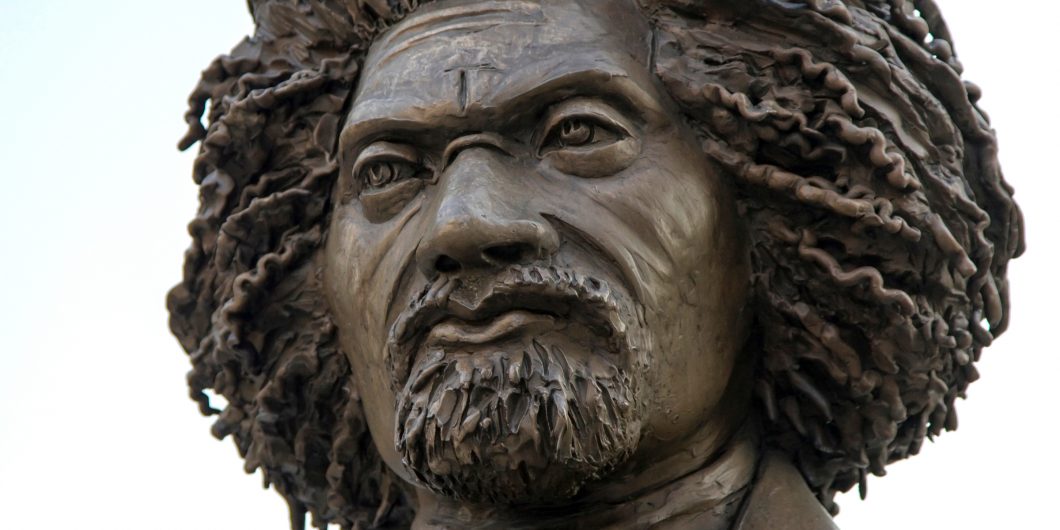Frederick Douglass’ Constitutional Bedrock
Frederick Douglass has deservedly been the subject of a number of excellent books in recent years. General readers may be familiar with David Blight’s magisterial biography, Frederick Douglass: Prophet of Freedom. Peter C. Myers’ Frederick Douglass: Race and the Rebirth of American Liberalism is the best book on Douglass’ political philosophy. The surge in interest in books on Douglass has merged with books reevaluating the relationship of slavery and the Constitution. In 2018, Princeton University historian, Sean Wilentz, published his bombshell No Property in Man: Slavery and Anti-Slavery at the Nation’s Founding and boldly challenged the reigning academic orthodoxy. Wilentz explained that he had agreed with the pro-slavery Constitution until the evidence compelled him to reverse his views. More recently, one of the deans of abolitionism, James Oakes, wrote The Crooked Path to Abolition: Abraham Lincoln and the Antislavery Constitution to carry Wilentz’s story up through the Civil War.
Perhaps then it is not surprising that this publishing milieu has seen the release of a new book on Douglass and the anti-slavery Constitution: A Glorious Liberty. With this book, Reason magazine journalist Damon Root has contributed a brief and readable volume aimed at a general audience. While the book does not necessarily present much new information on Douglass, its sharp focus on his constitutional views will help popularize the interpretation of the Constitution as an anti-slavery document.
A Glorious Liberty opens somewhat abruptly, focusing on the 1830’s with John Quincy Adams’ grand rhetorical and principled struggle against the infamous “gag rule” prohibiting the discussion of slavery in the House of Representatives. Adams’ constitutional understanding helped shape Douglass’ early view of how the institution of slavery conflicted with American republican principles.
Readers might be disappointed to get a meager three pages on Douglass’ background in slavery. While the book is not a full-scale biography, the absence is notable in fully grasping Douglass’ views. He had experienced the brutality and dehumanization of a system that repeatedly undermined his personhood and violently broke his spirit. The story of how he barely preserved his humanity through learning to read, fighting back against those who stripped his manhood away, and eventually escaping to freedom is central to understand why his constitutional views are ultimately so important. These are not biographical details to be treated lightly.
Root devotes the first part of the book to examining the well-known story of Douglass’ relationship with abolitionist and editor of The Liberator, William Lloyd Garrison. Garrison was a prominent abolitionist lecturer who helped launch Douglass’ career as a public speaker. Audiences were shocked by the eloquence of the former slave who was a powerful orator and held them spellbound with his stirring personal accounts of the horrors of slavery.
Garrison was an abolitionist who demanded immediate and unconditional emancipation. His uncompromising radicalism drew in a dedicated group of zealous followers. He did not merely see slavery as a contradiction or aberration in the American regime but adopted the view that the Constitution was a pro-slavery document. In Garrison’s view, the American republic was so thoroughly corrupted that the Union should be immediately broken up by the secession of the non-slaveholding northern states. He famously called the Constitution “a covenant with death and an agreement with hell,” and adopted the slogan, “NO UNION WITH SLAVEHOLDERS.”
Early on, Douglass adopted Garrison’s reading of the Constitution. His speeches from the mid-1840s are replete with references to the pro-slavery Constitution. He shared that message with audiences in Great Britain during a two-year speaking tour and at an anti-slavery convention in Syracuse, New York, where he said, “The Constitution I hold to be a radically and essentially slaveholding document.”
Garrison and Douglass began to drift further apart for personal and ideological reasons, until they finally had a falling out. Douglass increasingly resented being constrained to only speaking about his experiences as a slave and wanted to comment on the institution and articulate his abolitionist views. In short, he was tired of being trotted out as a living exhibit of an escaped enslaved person.
Douglass also devoted considerable effort to closely studying the documents of the American founding and came to hold a different political philosophy at odds with the Garrisonian view. Several individuals who were advocating for the anti-slavery constitutional view influenced Douglass’ thinking. Douglass credited Lysander Spooner’s The Unconstitutionality of Slavery and William Goodell’s Views of American Constitutional Law, in Its Bearing Upon American Slavery,as well as Liberty Party presidential candidate Gerrit Smith,with shaping his views.
Douglass thought a couple of the anti-Garrisonian arguments were particularly persuasive. He came to agree with the view that slavery was antithetical to a constitutional republic founded on the natural rights evident in the principles in the Preamble and due process clause of the Fifth Amendment. The institution also did not find any sanction in the Constitution, as constitutional protections for property could not be taken to endorse slavery because, in Douglass’ reading, there was “no property in man.” The rules of legal interpretation meant that any ambiguities had to be construed to support natural justice. Therefore, Douglass believed that slavery was immoral and illegal everywhere in the United States, and the federal government could outlaw slavery anywhere. Garrison thought the anti-slavery Constitution view was “utterly absurd and preposterous.”
Other issues helped to distance Douglass farther from Garrison. Douglass rejected Garrison’s pacifism and non-participation in politics. The rivals also launched into personal animosity as Garrison brooked no heresy against his positions and resented the competition Douglass’ North Star newspaper presented to The Liberator. Ideological differences caused the decisive break in their friendship, and Garrison vilified Douglass for his apostasy.
Root only spends one page analyzing Douglass’ 1860 Glasgow speech on the anti-slavery Constitution. In that speech he stated that the text of the Constitution supported neither slavery nor any property in man. Instead, those who believed the slavery clauses of the document overtly supported the institution misinterpreted them. It is a shame that the author did not devote a chapter to this seminal speech and more closely assess each of the slavery clauses and why Douglass believed they supported his reading of the Constitution as an anti-slavery document. This was a missed opportunity because the speech was the most thorough analysis Douglass made of each of the supposedly pro-slavery clauses of the Constitution. The speech is the clearest articulation of Douglass’ ideas that are central to the purpose of the book.
The book is neatly summed up by Root’s statement that Douglass time and again “returned to the bedrock liberal principles enshrined in America’s founding documents.”
Root compares Douglass’ view with that of a rising Abraham Lincoln in the late 1850s. The author sees much consistency in the ideas of Douglass and Lincoln in 1860. Root emphasizes that both rejected a property in man in the Constitution, both embraced the idea that slavery was a moral evil that violated the principle of equality in the Declaration, and that the federal government had the power to ban slavery in the territories. However, Douglass believed that the principles of the Preamble and natural rights basis of the Constitution was sufficient authority for the federal government to end slavery in the states where it existed. Lincoln took a more nuanced view that only the constitutional war power might enable the executive to do this. That significant difference between the two that deserves a lot more attention than the brief mention it receives in this book.
On the other hand, Root contrasts the views of Douglass with South Carolina senator John Calhoun. For Calhoun, slavery was not a necessary evil as it was for the founders but rather a “positive good” and a blessing. The assertion that “all men are created equal” was false and a dangerous political error in Calhoun’s estimation. The federal government had no power to end slavery anywhere, including the territories and Washington, D.C. Any attempt to do so would lead to a slippery slope of empowering the federal government to regulate or ban slavery where it already existed in the South.
Douglass marshalled his anti-slavery Constitution arguments in his critique of the Supreme Court’s decision in Dred Scott v. Sanford (1857). Chief Justice Roger Taney wrote that blacks were not citizens at the time of the Constitution and could not become citizens. Moreover, the Court declared the Missouri Compromise was unconstitutional because Congress had no power to regulate slavery in the territories.
Douglass welcomed the outbreak of the Civil War, which presented an opportunity to deal a “death-blow to the monster evil of slavery.” The Emancipation Proclamation had a moral power that made him joyous as he celebrated the “righteous decree.” He joined the war effort by acting as a recruiting agent for black soldiers. He promised the soldiers that the “musket means liberty.”
The chapter on the war provides interesting brief overviews of how Lincoln’s anti-slavery Constitution views and presidential war powers resulted in the Emancipation Proclamation. The story of the major events of the war are also told in vivid detail, especially for the all-black 54th Massachusetts regiment. But, Douglass curiously only makes brief appearances and his understanding of the anti-slavery Constitution completely drops out of the narrative.
The trouble with the Civil War chapter continues into the Reconstruction section. Douglass’ story is again subsumed by larger—and compelling—events related to the struggle for the Thirteenth, Fourteenth, and Fifteenth Amendments and other attempts at justice for freed persons. Equally dramatic and distressing are the horrific acts of violence and injustices blacks suffered for decades after the Civil War.
Douglass fought for black suffrage, citizenship, and constitutional rights after the war. He was outraged by several Supreme Court cases such as the Slaughter-House Cases (1873), curbing the application of the Fourteenth Amendment to the states, and the Civil Rights Cases (1883), that held the 1875 Civil Rights Act unconstitutional because they restricted the newly-won rights for black Americans. Root narrates Douglass’ well-known debate with woman suffragettes over the Fifteenth Amendment granting the vote to blacks. Douglass wanted all Americans to enjoy suffrage and equality, and was a long-time advocate of women’s suffrage since the 1848 Seneca Falls Convention. However, he thought that the polity should prioritize black male suffrage after the Civil War. An angry Elizabeth Cady Stanton countered that women should be granted the vote before black and immigrant males, and her arguments were marred by racist and xenophobic slurs.
Root adequately covers Douglass’ political and constitutional responses to the events of the late nineteenth century. However, he fails to grapple with Douglass’ oration on the memory of Abraham Lincoln at the unveiling of the Freedman’s Monument. Douglass’ profound reflections in that speech transcend even Lincoln and aim at understanding the nature of the American regime and the place of black Americans in that regime.
A Glorious Liberty is a solid introduction to an important topic of great relevance today as Americans deliberate over race and founding principles. The book is neatly summed up by Root’s statement that Douglass time and again “returned to the bedrock liberal principles enshrined in America’s founding documents.” The race problem in this country could be solved, according to Douglass, by “no longer evading the claims of justice.” Reflecting on Douglass’ life should help ensure that the public square does not escape his challenging claims.



